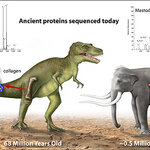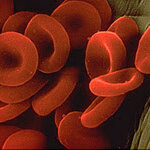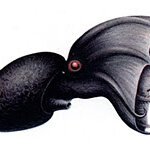Evolution

The rise of the central nervous system (CNS) in animal evolution has puzzled scientists for centuries. Vertebrates, insects and worms evolved from the same ancestor, but their CNSs are different and were thought to have evolved only after their lineages had split during evolution. Researchers from the European Molecular Biology Laboratory (EMBL) in Heidelberg now reveal that the vertebrate nervous system is probably much older than expected. The study, which is published in the current issue of Cell, suggests that the last common ancestor of vertebrates, insects and worms already had a…

Put a human and a chimpanzee side by side, and it seems obvious which lineage has changed the most since the two diverged from a common ancestor millions of years ago. Such apparent physical differences, along with human speech, language and brainpower, have led many people to believe that natural selection has acted in a positive manner on more genes in humans than in chimps.
But new research at the University of Michigan challenges that human-centered view.
"We often think that we're unique and superior to other species, so there must be a lot of Darwinian selection behind our origin,"…

Ancient aquatic amphibians developed the ability to feed on land before completing the transition to terrestrial life, researchers from Harvard University report this week in the Proceedings of the National Academy of Sciences.
Their work is based on analysis of the skulls of the first amphibians, which arose 375 million years ago, and their fish ancestors. The shapes of the junctions between adjacent skull bones -- termed "sutures" -- in the tops of these fish and amphibian skulls reveal how these extinct animals captured prey, say authors Molly J. Markey and Charles R. Marshall.
"Based on…

Researchers from Harvard Medical School and Beth Israel Deaconess Medical Center have captured and sequenced tiny pieces of collagen protein from a 68 million-year-old Tyrannosaurus rex. The protein fragments—seven in all—appear to most closely match amino acid sequences found in collagen of present day chickens.
Are birds and dinosaurs are evolutionarily related?
Researchers from Harvard Medical School and Beth Israel Deaconess Medical Center captured and sequenced tiny pieces of collagen protein from a 68 million-year-old Tyrannosaurus rex and a 160,000- to 600,000-year-old mastodon. The T…

Coleoptera (beetles) are one of the most successful groups of organisms on Earth. Their success in evolutionary terms is recognised by their extreme adaptive diversity (occupying almost every possible ecological niche) and their longevity (fossils from the Palaeozoic, 280 million years ago). But most of all, their success is indisputable in their sheer species numbers: with over 350,000 named species and many more to be described, they constitute about one fourth of all species on the Planet.
It is commonly accepted that phytophagous beetles and their host plants (mainly the likewise…

Fossils turn up in the most unusual places. Simone Casati, an amateur paleontologist, was exploring the famed vineyards of Italian winemaker, Castello Banfi, when he came across a small piece of bone poking out of the soil. He started digging and realized that he had unearthed more then he had e anticipated: a 10m (33ft) long skeleton of an ancient whale.
The rich soil of the vineyards was laid down five millions years ago in the Pliocene, a time when Tuscany was covered by a warm, shallow sea rich in fauna.
The skeleton, which resembles a modern rorqual whale, is almost complete and…

Scientists from the universities of Exeter and Cambridge have turned a textbook example of sexual selection on its head and shown that females may be more astute at choosing a mate than previously thought.
New research, funded by the Leverhulme Trust and published in Current Biology, shows that differences in the lengths of the long tail feathers possessed by male barn swallows are more about aerodynamics than being attractive. Female barn swallows favour mates with longer tails and the prominent male tail ‘streamers’ that extend beyond the tail were cited by Darwin as evidence of sexual…

I grew up in the prairies and one of my favourite ways to relieve the boredom of long summer road trips was to examine the different bugs splattered on the windshield. I would try to figure out which bug each splatter was and I was fascinated by the ways some left green smears or bright, thick, yellow splats. It made me wonder why animals have different colours of blood and how many different colours there are.
Humans blood is made of an amber coloured liquid called plasma and numerous red blood cells (about 25,000,000,000,000), which lend their colour to our blood. Each red blood cell uses…

Horizon: My Pet Dinosaur was broadcast on BBC Two on 13 March at 21:00GMT. The idea behind the program is what would have happened if the dinosaurs hadn’t gone extinct? This sounds like a fantastic idea for a program and I am all for popularizing science, I believe public interest in scientific research is important. But some of these popularizations go to far; there are bound to be small anatomical mistakes in TV shows, even some hypotheses based on limited evidence, but what I hate is unreined wild speculation.
Several palaeontologists including Kristi Curry-Rogers and Phil Currie lent…

Its deep velvety black colour, huge red eyes and a webbing of skin connecting eight arms earned this animal the name Vampyroteuthis infernalis, which literally translated means ‘Vampire squid from hell’. It is a small, deep-sea animal, neither an octopus or a squid but a relative and phylogenetic relic or living fossil first described in 1903 by Carl Chun.
The vampire squid is an extremophile, living at depths from 600-900 meters (2,000-3,000 feet). Sunlight does not penetrate the darkness here, pressure is high and oxygen saturation is 3%. But the vampire squid is so beautifully adapted to…